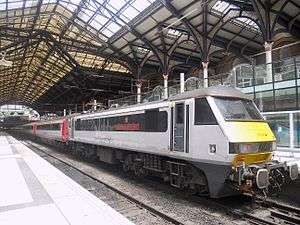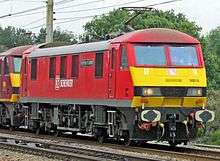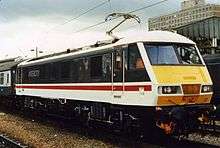British Rail Class 90
| British Rail Class 90 | |||||||||||||||||||||||||||||||||||||||||||||||||
|---|---|---|---|---|---|---|---|---|---|---|---|---|---|---|---|---|---|---|---|---|---|---|---|---|---|---|---|---|---|---|---|---|---|---|---|---|---|---|---|---|---|---|---|---|---|---|---|---|---|
 Greater Anglia 90012 at London Liverpool Street in 2016 | |||||||||||||||||||||||||||||||||||||||||||||||||
| |||||||||||||||||||||||||||||||||||||||||||||||||
| |||||||||||||||||||||||||||||||||||||||||||||||||
| |||||||||||||||||||||||||||||||||||||||||||||||||
| |||||||||||||||||||||||||||||||||||||||||||||||||
The British Rail Class 90 electric locomotives were built by British Rail Engineering Limited at Crewe Works in 1987-1990, weighing 84.5 tonnes and with a top speed of 110 mph (177 km/h). They operate from 25 kV AC overhead lines and produce 5,000 bhp (3,700 kW). The class is employed on express passenger and heavy freight trains.
Description
Fifty were built in the late 1980s, numbered 90001-050. They were developed from the Class 87, with many improvements and new features, and were initially classified as the Class 87/2 prior to introduction.[1] However, due to many visual and technical differences, they were reclassified.[1] The Class 90s were primarily built to replace the ageing Class 81s, Class 82s, Class 83s, Class 84s, Class 85s and the Class 86s, dating from the early 1960s, which were prone to having faults as well as a fire risk.
The class is fitted with rheostatic brakes in addition to standard Westinghouse air brake equipment. A Time-Division Multiplexer (TDM) is fitted to enable two or more locomotives to work in multiple. It also allows a Class 90 to work a push-pull passenger train with a Driving Van Trailer (DVT), DBSO or Propelling Control Vehicle.
In the early 1990s, with the sectorisation of British Rail, 26 locomotives were dedicated for freight traffic; they were reclassified Class 90/1 and renumbered 90125-150 by the addition of 100 to the original number. The modifications included lowering the maximum speed to 75 mph (121 km/h) and isolating the electric train supply. Many of these locomotives were repainted in the new Railfreight Distribution two-tone grey livery, which was replaced by a revised version in 1994. Three locomotives, 90128, 90129 and 90130, received special "continental" liveries (NMBS/SNCB blue, Deutsche Bahn red, SNCF grey respectively) to celebrate the Freightconnection event in 1992.
Around the same time, five locomotives, 90016-020, were repainted into the new Rail Express Systems livery and dedicated to postal trains. They were primarily used on London-Glasgow, London-Newcastle and Birmingham-Glasgow services.
Of the remaining locomotives, the first 15, 90001-015, were operated by InterCity West Coast on express passenger services. 90021-024 were operated by Railfreight Distribution, but remained as standard Class 90/0 locomotives to enable them to rescue passenger trains.
Many Class 90 locomotives have received names. The passenger locomotives were named after cities, newspapers or famous institutions. Many of the freight locomotives have been given names with a commercial link. The Class 90 was the first new locomotive to carry InterCity Swallow livery

Current operators
Upon the privatisation of British Rail in 1996, the Class 90 fleet was divided between several operators.
DB Cargo UK
English Welsh & Scottish acquired the largest fleet, 20 locomotives from Railfreight Distribution and five from Rail Express Systems. DB Schenker UK (now DB Cargo) were contracted to provide locomotives for the Caledonian Sleeper services between Scotland and London Euston, and the Class 90s were frequently used for this purpose as well as on freight duties. An agreement was reached in 2006 to livery a number of Class 90s for First ScotRail, for their exclusive use hauling the Caledonian Sleeper. In 2015, with Serco taking over the Caledonian Sleeper Franchise, the haulage contract went to GB Railfreight, who chose to use Class 92s on the electrified legs of the Sleeper services. However, due to problems with the overhauled 92s, Class 90s had a brief reprieve on the Sleeper, first from DB Schenker, and then Freightliner; 90s still sporadically appear when a 92 is unavailable.
Freightliner
Freightliner inherited 10 Class 90/1 locos, These have since been returned to their original Class 90/0 configuration.
Greater Anglia
In early 2004 Anglia, (later became "ONE") needed a replacement for their ageing Class 86 locomotives on the Great Eastern Main Line. At the same time Virgin Trains was starting to retire its Class 90 locomotives as Class 390 units were introduced. A deal was struck and progressively 90001 - 90015 were delivered to Norwich Crown Point to replace the Class 86s.
National Express passed their franchise onto Abellio Greater Anglia in February 2012, who now operate the locos.
The Greater Anglia fleet is scheduled to be replaced. In August 2016 it was announced Stadler Rail to build 10 Class 745 Stadler FLIRT Electric multiple units, which will come into service between January 2019 and September 2020.[4]
Former operators
Virgin Trains
Virgin Trains inherited 15 locomotives, 90001-015, to work passenger trains on the West Coast Main Line (WCML). They were based at Willesden depot in London for services from London Euston to Birmingham New Street, Wolverhampton, Crewe, Manchester Piccadilly, Liverpool Lime Street, Preston and Glasgow Central.
In 1998, 90002 became the first locomotive to be repainted in Virgin Trains' red and black livery. It was named "Mission: Impossible" to launch the challenge of upgrading passenger services on the WCML. The rest of the fleet was quickly repainted into the new livery.
In 2002, Class 390 Pendolino electric multiple units started to enter service to replace locomotive-hauled trains on the WCML. The first locomotives to be replaced were the elderly Class 86/2s and some of the less reliable Class 87 locomotives. However, since the Class 90 fleet was relatively small and subsequently non-standard, it was decided to retain the larger Class 87 fleet. Therefore, from March 2004, Virgin started to replace its Class 90 fleet, being transferred to the new 'one' (later National Express East Anglia) franchise.
The final service operated by a Virgin-liveried Class 90 was on 27 August 2004, 90015 London Euston-Glasgow Central and return.
Following the derailment of 390033 at Grayrigg in 2007, Virgin Trains had the need for an additional set. As a result, Virgin used Class 90 locomotives hired from DB Schenker, but more recently Freightliner, along with a rake of Mark 3 coaching stock and a DVT. Nicknamed the Pretendolino, this received re-upholstered seating, power points, wi-fi and a full external re-paint at Wabtec, Doncaster in 2009.[5] Virgin used this set with a Class 90 locomotive hired from Freightliner on a Euston to Crewe (via Birmingham) Friday relief service until December 2012, and also hired the train out as a charter train. It is sometimes used on London - Birmingham services in the event of a Pendolino shortage.
From the December 2013 timetable change, Virgin Trains used the Mk3 set once again on London - Birmingham services on a Thursday and Friday only basis, Class 90s leased from Direct Rail Services (which were sub-leased from DB Schenker) were used once again. This set was retired from service on 25 October 2014 with a rail tour the following day. In November 2014 the "Pretendolino" was transferred to Norwich Crown Point depot to enter service with Abellio Greater Anglia having come to the end of its agreed lease to Virgin Trains.
East Coast Main Line
In the late 1990s, GNER hired class 90s to stand in for Class 91s on London Kings Cross and Leeds services. One (90024) was repainted in GNER livery. In 2016, DB Cargo Class 90s were returned to the East Coast Main Line on Virgin Trains East Coast London to Newark North Gate, Leeds, and Newcastle services, whilst the Class 91 locomotives are overhauled.[6] These continue to be operated by London North Eastern Railway.
Fleet
| Subclass | Number built (year) | TOPS number range | Operators | Comments |
|---|---|---|---|---|
| Class 90/0 | 50 (1987-90) | 90001-90015 | Greater Anglia | |
| 90017-90040 | DB Cargo UK | 90017, 90022-90025, 90027, 90030-90033, 90036 and 90038 are stored at Crewe Electric TMD. 90033 has been stripped for spares. 90021 is in First ScotRail livery. 90022, 90027, 90033 and 90038 are in the revised Railfreight Distribution Livery. 90025 is in the older Railfreight Distribution livery. 90017, 90020, 90023, 90026, 90028, 90030, 90031, 90032, 90037 and 90039 are in EWS Livery. 90018 and 90040 are currently still wearing now defunct Schenker branding in the DB red livery. 90034 is in DRS Blue with DB branding. 90019, 90029 and 90036 are in the revised DB Cargo livery. 90024 is in promotional Malcolm Logistics livery. | ||
| 90016, 90041-90050 | Freightliner | 90050 was withdrawn after catching fire in 2004; currently stored at Crewe Basford Hall as a source of spare parts. 90042, 90043, 90045 and 90049 are currently in Freightliner Powerhaul Livery. 90016, 90041 and 90046 are in Freightliner 'Racing Green' Livery 90044, 90047 and 90048 are in Original Freightliner Two Tone Grey Livery. |
Gallery
- 90016 at London Liverpool Street in 2004, in Rail Express Systems livery.
 90036 on loan to one from EWS at Liverpool Street in 2007.
90036 on loan to one from EWS at Liverpool Street in 2007. EWS 90019 in First ScotRail livery at London Euston station in 2007.
EWS 90019 in First ScotRail livery at London Euston station in 2007.- 90049 in original Freightliner grey livery at Ipswich in 2003
- 90015 "The International Brigade Spain 1936-1939" at Carlisle on 27 August 2004 on the final Class 90-hauled service for Virgin Trains until 2007.
.jpg) 90002 in One livery at London Liverpool Street.
90002 in One livery at London Liverpool Street. 90024 in GNER colours at London Liverpool Street.
90024 in GNER colours at London Liverpool Street. 90035 at Euston in EWS livery.
90035 at Euston in EWS livery.
References
- 1 2 3 4 5 Morrison 2013, p. 59
- 1 2 3 4 5 6 7 8 9 10 11 12 13 14 15 16 17 Marsden & Fenn 2001, p. 117
- ↑ "Glossary of Terms". Scot-Rail.co.uk. Retrieved 12 September 2018.
- ↑ Abellio wins East Anglian rail franchise for nine years in £1.4bn deal East Anglian Daily Times 10 August 2016
- ↑ Charter train potential for Virgin Trains 'new-look' loco-hauled trainset Virgin Trains Press Release 1 July 2009
- ↑ "DB Class 90 to operate on King's Cross-Newark Northgate route" Rail Magazine issue 807 17 August 2016 page 32
Sources
Further reading
External links
| Wikimedia Commons has media related to British Rail Class 90. |
